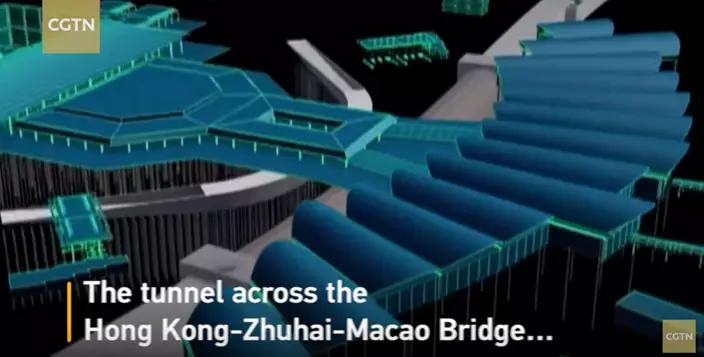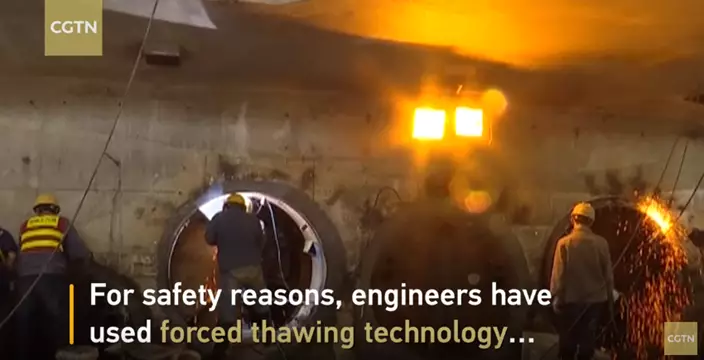The Gongbei Tunnel, consisting of a two-way highway of six lanes, covers a cross-section area of 345 square meters.

It is the world's largest highway tunnel in terms of cross-section area, over 30 meters under the ground.
Engineers have used forced thawing technology to artificially unfreeze a main tunnel of the Hong Kong-Zhuhai-Macao Bridge to reduce the risk of ground settlement.

The whole construction of the tunnel will finish by late November.

SACRAMENTO, Calif. (AP) — California Gov. Gavin Newsom's administration said Thursday it will now cost more than $20 billion to build a giant tunnel aimed at catching more water when it rains and storing it to better prepare for longer droughts caused by climate change.
State regulators have been trying to build some version of a water tunnel system for decades. The latest form championed by the Democratic governor is a single giant tunnel, down from two tunnels proposed by his predecessor, Jerry Brown. Newsom's administration says the state can capture more water from the Sacramento River during major storms and send it south for storage.
The last cost estimate, which came in 2020, put the price tag for a single tunnel project at $16 billion. The new analysis says the tunnel will cost $20.1 billion, an increase they attribute almost entirely to inflation, which soared after the pandemic.
The project would be paid for by 29 local public water agencies, who get their money from customers.
The analysis, conducted by the Berkeley Research Group but paid for by the state, said the tunnel would yield $38 billion in benefits, mostly because of an increased water supply that would be better protected from natural disasters like earthquakes.
“The benefits clearly justify the costs,” said David Sunding, emeritus professor at the University of California, Berkeley who led the analysis.
Despite that rosy outlook, the tunnel remains one of the most controversial projects in recent memory. Environmental groups say its construction would have devastating impacts on the already vanishing ecosystem of the Sacramento-San Joaquin River Delta, the largest estuary on the West Coast that is home to endangered species of salmon and other fish.
The analysis released Thursday notes the environmental impacts include lost agricultural land, reduced water quality in the Delta, and impacts on air quality, transportation and noise.
“Instead of foisting the costs of this boondoggle project onto Californians, the state should invest in sustainable water solutions that promise to restore the Delta ecosystem, not destroy it," said Barbara Barrigan-Parilla, executive director of the environmental advocacy group Restore the Delta.
State officials note the project now includes $200 million for grants to fund local projects in areas impacted by construction.
Beyond environmental concerns, the project has become a political landmine throughout the Central Valley's farming communities, where it is seen as yet another attempt by Southern California to steal their water. While most of California's population lives in the southern part of the state, most of the state's water comes from the north. In the state Legislature, lawmakers have blocked any effor t to benefit or speed up the tunnel's construction.
"This new analysis acknowledges what we’ve known all along: the Delta Tunnel is meant to benefit Beverly Hills and leave Delta communities out to dry,” said U.S. Rep. Josh Harder, a Democrat whose district includes the Central Valley communities like Stockton, Lodi and Galt. "I’m sick and tired of politicians in Sacramento ignoring our Valley voices and I will do everything in my power to stop them from stealing our water.”
The tunnel would be part of the State Water Project — a complex system of reservoirs, dams and canals that provides water to 27 million people while irrigating 750,000 acres (303,515 hectares) of farmland.
Climate change is threatening that supply. A recent drought saw the three direst years on record, which dropped reservoirs around the state to dangerously low levels and prompted mandatory rationing and even caused some hydroelectric power plants to shut down. State officials predict that by 2070 State Water Project deliveries will decline by 22% because of climate change.
The proposed tunnel would be about 45 miles (72 kilometers) long and 36 feet (11 meters) wide, or large enough to carry more than 161 million gallons of water per hour. State officials say this tunnel would let the state capture more water when the state is hit by “atmospheric rivers” — large storms that can drench the state for weeks during the rainy season.
The analysis released Thursday says the tunnel would increase water deliveries by about 17%, nearly accounting for the anticipated decline because of climate change.
“There is a very real cost to do nothing. It is vastly more efficient and economical to avoid declining supplies," said Karla Nemeth, director of the California Department of Water Resources. “Water shortages, mandatory restrictions, land fallowing and job loss all impact our state and local economies.”

FILE – A sign opposing a plan to build a giant tunnel to ship water to Southern California is displayed near Freeport, California, May 2, 2016. California Gov. Gavin Newsom's administration now says it will cost more than $20 billion to build a giant tunnel so the state can catch more water when it rains and store it to better prepare for longer droughts caused by climate change. (AP Photo/Rich Pedroncelli, File)

FILE - A ship moves through the Sacramento-San Joaquin River Delta near Bethel Island, Calif., March 12, 2008. California Gov. Gavin Newsom's administration now says it will cost more than $20 billion to build a giant tunnel so the state can catch more water when it rains and store it to better prepare for longer droughts caused by climate change. (AP Photo/Rich Pedroncelli, File)








